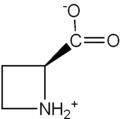Formula C4H7NO2 Density 1.28 g/cm³ | Molar mass 101.104 g/mol Appearance crystalline solid | |
 | ||
Azetidine-2-carboxylic acid (abbreviated Aze) is a plant non-protein amino acid homologue of proline with the molecular formula C4H7NO2. Aze is a heterocyclic, 4 membered ring with nitrogen as its heteroatom (an azetidine), and a carboxylic acid group substituted on one of the ring carbon atoms. The main difference between Aze and proline is the ring of Aze has four members and the ring of proline has five. Aze has the ability to act as an analog of proline and can be incorporated into proteins in place of proline.
Contents
Synthesis
Optically inactive Aze was obtained in small yield from γ-aminobutyric acid by α-bromination, followed by removal of hydrogen bromide from the intermediate γ-amino-α-butyric acid and ring closure by treatment with a barium hydroxide solution. An optically active Aze was obtained by treatment of αγ-diaminobutyric acid dihydrochloride with a mixture of nitrous and hydrochloric acids to yield γ-amino-α-chlorobutyric acid, followed by elimination of hydrogen chloride and cyclization by treatment with barium hydroxide.
Occurrence
Azetidine-2-carboxylic acid has been known since 1955 to be present in rhizomes and fresh foliage of certain plants. It is known to occur in two species, Convallaria majalis (lily of the valley), and Polygonatum officinale, from the flowering plant family, Ruscaceae.
Aze is also found in numerous plants from the family Fabaceae, and has also been detected in small quantities in table beets, garden beets, and sugar beets.
Toxicity
It has been shown that when Azetidine-2-carboxylic acid is misincorporated into proteins in place of proline, Aze deters the growth of competing vegetation and poisons predators. Other studies have shown effects of Aze resulting in a wide range of toxic and teratogenic disorders, including in a range of malformations, in various animal species including ducks, hamsters, mice, and rabbits.
Misincorporation of Aze into human proteins can alter collagen, keratin, hemoglobin, and protein folding. However, the lack of detailed toxicologic data and the need for more direct evidence about the damaging effects of the misincorporation of Aze on specific proteins are reasons why the toxicity of Aze to humans cannot be determined at this time.
